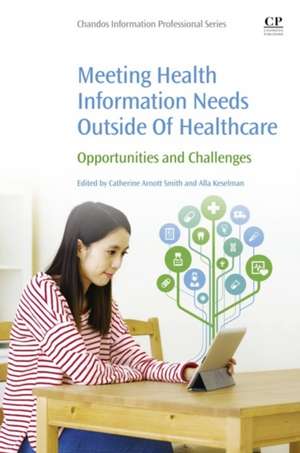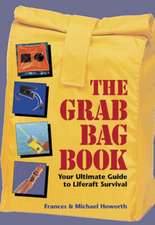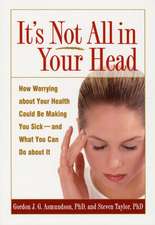Meeting Health Information Needs Outside Of Healthcare: Opportunities and Challenges
Autor Catherine Arnott Smith, Alla Keselmanen Limba Engleză Paperback – 4 aug 2015
Professionals working in a range of fields, including librarianship, computer science and health information technology, journalism, and health communication can be involved in providing consumer health information, or health information targeting laypeople. This volume clearly examines the properties of health information that make it particularly challenging information to provide in diverse settings.
- Addresses professional challenges and ethical problems of communicating health information to lay people in non-clinical settings
- Focuses on health information as a challenge for different professionals providing health information in different settings
- Emphasizes the shared challenges of information practice across different settings as well as those facing professionals in different roles
Preț: 344.90 lei
Preț vechi: 363.06 lei
-5% Nou
Puncte Express: 517
Preț estimativ în valută:
65.99€ • 68.90$ • 54.62£
65.99€ • 68.90$ • 54.62£
Carte tipărită la comandă
Livrare economică 28 martie-11 aprilie
Preluare comenzi: 021 569.72.76
Specificații
ISBN-13: 9780081002483
ISBN-10: 0081002483
Pagini: 376
Dimensiuni: 152 x 229 x 20 mm
Greutate: 0.61 kg
Editura: ELSEVIER SCIENCE
Locul publicării:OXford
ISBN-10: 0081002483
Pagini: 376
Dimensiuni: 152 x 229 x 20 mm
Greutate: 0.61 kg
Editura: ELSEVIER SCIENCE
Locul publicării:OXford
Cuprins
- Series Editor
- About the authors
- Editors’ foreword
- Acknowledgments
- Overview
- 1. Designing health information programs to promote the health and well-being of vulnerable populations: the benefits of evidence-based strategic health communication
- 1.1. Introduction
- 1.2. Barriers
- 1.3. Lessons learned: improving health communication for vulnerable populations
- 1.4. Strategies to develop strategic communication
- 1.5. Evaluating health communication
- 1.6. Practice implications
- 2. Health literacy research’s growth, challenges, and frontiers
- 2.1. Introduction
- 2.2. Four milestones in health literacy research
- 2.3. Health literacy’s evolving definition and conceptual underpinnings
- 2.4. The range and vitality of health literacy research
- 2.5. Health literacy research’s current needs and frontiers
- 2.6. Conclusions
- 1. Designing health information programs to promote the health and well-being of vulnerable populations: the benefits of evidence-based strategic health communication
- Libraries
- 3. Medical information for the consumer before the World Wide Web
- 3.1. Introduction: “Closed to the Public
- 3.2. Background: the beginnings of consumer health information
- 3.3. Libraries
- 3.4. Librarian
- 3.5. The patron
- 3.6. Content
- 3.7. Conclusions
- 4. Ethical health information: Do it well! Do it right! Do no harm!
- 4.1. Introduction
- 4.2. Responsibility for the best possible information service
- 4.3. The right to privacy and responsibility for confidentiality
- 4.4. Providing fair and equitable access
- 4.5. Intellectual property rights and access to information
- 4.6. Advocacy for information access
- 4.7. Providing information versus giving advice
- 4.8. Conflicting values, dilemmas, and tough decisions
- 4.9. Keep learning
- 5. Health information resource provision in the public library setting
- 5.1. Background
- 5.2. Challenges
- 5.3. Case study: embedded consumer health librarians in Delaware
- 5.4. Conclusions
- 6. Who needs a health librarian? Ethical reference transactions in the consumer health library
- 6.1. Introduction
- 6.2. The reference transaction: asking the right questions, avoiding the wrong answers
- 6.3. Looking for the answers: symptom-checkers and self-diagnosing
- 6.4. What did the doctor say? Health literacy and deciphering a whole new language
- 6.5. When the answers have questions: experimental treatments and integrative medicine
- 6.6. Conclusions
- 7. Consumer health information: the community college conundrum
- 7.1. The community college setting
- 7.2. Health information needs at the community college
- 7.3. Issues in health information provision
- 7.4. Health literacy in the community college setting
- 7.5. The future for community colleges and health information
- 7.6. Conclusions
- Appendix A: Community and Junior College Libraries Section (CJCLS) of the Association of College and Research Libraries
- 3. Medical information for the consumer before the World Wide Web
- Contexts
- 8. Health information delivery outside the clinic in a developing nation: The Qatar Cancer Society in the State of Qatar
- 8.1. Introduction and background
- 8.2. Qatar
- 8.3. Methods
- 8.4. Sources of consumer health information in the GCC
- 8.5. Barriers to health care in Qatar
- 8.6. The Qatar Cancer Society
- 8.7. Cancer information delivery outside the clinical setting
- 8.8. Conclusions
- Appendix 1: Questionnaire
- 9. Health information and older adults
- 9.1. Introduction
- 9.2. Background
- 9.3. Settings: where do older adults go for information?
- 9.4. Health information format considerations
- 9.5. Format summary
- 9.6. Health information comprehension among older adults: barriers and solutions
- 9.7. Comprehension summary
- 10. Re-envisioning the health information-seeking conversation: insights from a community center
- 10.1. Introduction
- 10.2. Understanding information behaviors
- 10.3. Health information seeking in a local context
- 10.4. Conclusions
- 11. For the mutual benefit: health information provision in the science classroom
- 11.1. Background
- 11.2. The science classroom as a setting for health literacy
- 11.3. Challenges and opportunities for bringing health education into the science classroom
- 11.4. Conclusions and implications
- 12. “You will be glad you hung onto this quit: sharing information and giving support when stopping smoking online
- 12.1. Introduction
- 12.2. Interpersonal aspects of advice-giving and showing support online
- 12.3. Methodology
- 12.4. Results and discussion
- 12.5. Conclusions
- 13. Health information in bits and bytes: considerations and challenges of digital health communication
- 13.1. Introduction
- 13.2. The health programs
- 13.3. The digital divide
- 13.4. Don’t make me think
- 13.5. Humanizing technology
- 13.6. Know your audience
- 13.7. Data dilemmas
- 13.8. Conclusions
- 14. Does specialization matter? How journalistic expertise explains differences in health-care coverage
- 14.1. Introduction
- 14.2. Why specialization should matter
- 14.3. Methodology
- 14.4. Results
- 14.5. Discussion
- 14.6. Conclusions
- 8. Health information delivery outside the clinic in a developing nation: The Qatar Cancer Society in the State of Qatar
- Afterword
- Index







